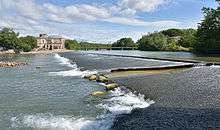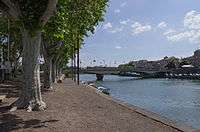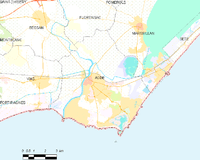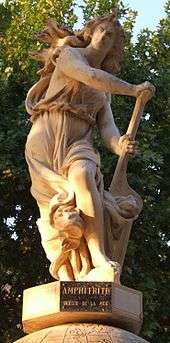Agde
| Agde | ||
|---|---|---|
|
Hotel la Galiote in front of the cathedral | ||
| ||
 Agde | ||
|
Location within Occitanie region  Agde | ||
| Coordinates: 43°18′39″N 3°28′33″E / 43.3108°N 3.4758°ECoordinates: 43°18′39″N 3°28′33″E / 43.3108°N 3.4758°E | ||
| Country | France | |
| Region | Occitanie | |
| Department | Hérault | |
| Arrondissement | Béziers | |
| Canton | Agde | |
| Intercommunality | Hérault Méditerranée | |
| Government | ||
| • Mayor (2014–2020) | Gilles d'Ettore (UMP) | |
| Area1 | 50.81 km2 (19.62 sq mi) | |
| Population (2008)2 | 22,487 | |
| • Density | 440/km2 (1,100/sq mi) | |
| Time zone | CET (UTC+1) | |
| • Summer (DST) | CEST (UTC+2) | |
| INSEE/Postal code | 34003 / 34300 | |
| Elevation |
0–110 m (0–361 ft) (avg. 5 m or 16 ft) | |
|
1 French Land Register data, which excludes lakes, ponds, glaciers > 1 km² (0.386 sq mi or 247 acres) and river estuaries. 2 Population without double counting: residents of multiple communes (e.g., students and military personnel) only counted once. | ||
Agde (French pronunciation: [aɡdə]; Occitan: Agde [ˈadde, ˈate]) is a commune in the Hérault department in southern France. It is the Mediterranean port of the Canal du Midi.
Location


Agde is located on the River Hérault, 4 kilometres (2 miles) from the Mediterranean Sea, and 750 kilometres (466 miles) from Paris. The Canal du Midi connects to the Hérault at the Agde Round Lock ("L'Écluse Ronde d'Agde") just above Agde and the Hérault flows into the Mediterranean at Le Grau d'Agde.
History
Foundation
Agde (525 B.C.) is one of the oldest towns in France, right behind Béziers (575 B.C.) and Marseilles (600 B.C.).[1] Agde (Agathe Tyche, "good fortune") was a 5th-century B.C. Greek colony settled by Phocaeans from Massilia. The symbol of the city, the bronze Ephebe of Agde, of the 4th century BCE, recovered from the fluvial sands of the Hérault, was joined in December 2001 by two Early Imperial Roman bronzes, of a child and of Eros, which had doubtless been on their way to a villa in Gallia Narbonensis when they were lost in a shipwreck.
Development

In the history of Roman Catholicism in France, the Council of Agde was held 10 September 506 at Agde, under the presidency of Caesarius of Arles. It was attended by thirty-five bishops, and its forty-seven genuine canons dealt "with ecclesiastical discipline". One of its canons (the seventh), forbidding ecclesiastics to sell or alienate the property of the church from which they derived their living, seems to be the earliest mention of the later system of benefices.[2][3]
Population
| Historical population | ||
|---|---|---|
| Year | Pop. | ±% |
| 1793 | 6,744 | — |
| 1800 | 6,744 | +0.0% |
| 1806 | 7,639 | +13.3% |
| 1821 | 7,726 | +1.1% |
| 1831 | 8,202 | +6.2% |
| 1836 | 8,230 | +0.3% |
| 1841 | 8,251 | +0.3% |
| 1846 | 8,884 | +7.7% |
| 1851 | 9,115 | +2.6% |
| 1856 | 9,439 | +3.6% |
| 1861 | 9,747 | +3.3% |
| 1866 | 9,586 | −1.7% |
| 1872 | 8,829 | −7.9% |
| 1876 | 8,251 | −6.5% |
| 1881 | 8,170 | −1.0% |
| 1886 | 8,446 | +3.4% |
| 1891 | 7,389 | −12.5% |
| 1896 | 8,478 | +14.7% |
| 1901 | 9,533 | +12.4% |
| 1906 | 8,435 | −11.5% |
| 1911 | 9,265 | +9.8% |
| 1921 | 8,325 | −10.1% |
| 1926 | 9,360 | +12.4% |
| 1931 | 9,605 | +2.6% |
| 1936 | 9,242 | −3.8% |
| 1946 | 7,592 | −17.9% |
| 1954 | 7,897 | +4.0% |
| 1962 | 8,751 | +10.8% |
| 1968 | 10,184 | +16.4% |
| 1975 | 11,605 | +14.0% |
| 1982 | 13,107 | +12.9% |
| 1990 | 17,583 | +34.1% |
| 1999 | 20,066 | +14.1% |
| 2008 | 22,487 | +12.1% |
Agde's inhabitants are called Agathois.
Architecture


Agde is known for the distinctive black basalt used in local buildings such as the cathedral of Saint Stephen, built in the 12th century to replace a 9th-century Carolingian edifice built on the foundations of a fifth-century Roman church.
Bishop Guillaume fortified the cathedral's precincts and provided it with a 35-metre donjon (keep). The Romanesque cloister of the cathedral was demolished in 1857.
Jewish community
It is assumed that a Jewish community was established in the town around the sixth century AD. During the council of Agde, assembled by the Catholic church in 506 AD, Christian laymen and ecclesiastics were prohibited from eating with Jews or hosting them. This prohibition suggests that the town Jews held good relations with their town neighbours. It is also assumed that the Jewish community was never large, since it did not own a cemetery and buried their dead in Béziers, three miles away.[5]
The Jewish name of the city was Agdi, or Akdi (אגדי).[6] During World War II, about two thousand Jews from Germany and Austria were sent to a labour camp near the town; most were deported on 24 August 1942.[7]
Sport and leisure
Agde has a football club RCO Agde who play at the Stade Louis Sanguin.[8] They currently play in the Championnat de France amateur 2.
Agde also has a rugby club, Rugby Olympique Agathois (ROA), who play in the French Federale 1 competition.
Twin towns - sister cities
| Town | State/Region | Country |
|---|---|---|
| Antequera | |
|
See also
- Cap d'Agde, the seaside resort of Agde
- Ancient Diocese of Agde
- List of traditional Greek place names
- Communes of the Hérault department
References
- ↑ Ludovic Trabuchet. "Des révélations sur le passé grec de Béziers". Midilibre.fr. Retrieved 2013-03-25.
- ↑ "CATHOLIC ENCYCLOPEDIA: Council of Agde". www.newadvent.org. Archived from the original on 29 October 2009. Retrieved 2009-10-08.
- ↑ "Medieval Sourcebook: Council of Agde: Concerning Slaves of the Church, 506". www.fordham.edu. Retrieved 2009-10-08.
- ↑ The sculpture rebaptised Amphitrite formerly stood on the façade of the Palais du Trocadéro, built for the Exposition Universelle (1878) and demolished to make way for the Exposition of 1937. She was preserved and offered to the city, where she now symbolizes Agde's maritime vocation. (Patrimoine français; Hérault Tribune Découvrir Agde)
- ↑ AGDE - JewishEncyclopedia.com
- ↑ Agde - Encyclopaedia Judaica | Encyclopedia.com
- ↑ "- Gale - Enter Product Login". galegroup.com.
- ↑ "France - RC Olympique Agathois - Results, fixtures, squad, statistics, photos, videos and news - Soccerway". soccerway.com.
- ↑ "Spanish local corporations twinned with Europe" (PDF). Spanish Federation of Municipalities and Provinces. Retrieved October 30, 2009.

External links
| Wikimedia Commons has media related to Agde. |
- (French) Agde (official site)
- (French) Agde has one of the biggest naturist centres of Europe
- Richard Stillwell, ed. Princeton Encyclopædia of Classical Sites, 1976: "Agatha (Agde) Hérault, France"
- Recent undersea find of bronzes
.svg.png)